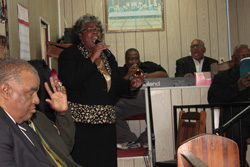This event set the restless nervousness and fear of the white establishment ablaze. Afraid of what a successful challenge could do to upset their way of life, hundreds of white people in Phillips County amassed weapons and also requested federal support to put down a black “insurrection.” Five hundred battle-tested troops from Camp Pike – a military base just outside of Little Rock – were sent to Elaine.
 There are various estimates of the number of African Americans and whites that were killed. Grif Stockley, a scholar that has extensively researched the Elaine Massacre writes, “It is documented that five whites, including a soldier, died at Elaine, but estimates of African American deaths, made by individuals writing about the Elaine affair between 1919 and 1925, range from 20 to 856.”[3]
There are various estimates of the number of African Americans and whites that were killed. Grif Stockley, a scholar that has extensively researched the Elaine Massacre writes, “It is documented that five whites, including a soldier, died at Elaine, but estimates of African American deaths, made by individuals writing about the Elaine affair between 1919 and 1925, range from 20 to 856.”[3]
The travesty in Elaine has never been addressed or acknowledged by local law enforcement or the federal government. Hence, it would not be a far stretch to put forward that the Healing the Land event has historic resonance not only for the community of Elaine but perhaps for other “Red Summer” communities that still harbor unaddressed racial grievances.
 The program consisted of several speakers from the community and ended with a procession to Hoop Spur Crossing, the site of the church where roughly one hundred members of the Progressive Farmers and Household Union held their meeting on the evening of September 30, 1919.
The program consisted of several speakers from the community and ended with a procession to Hoop Spur Crossing, the site of the church where roughly one hundred members of the Progressive Farmers and Household Union held their meeting on the evening of September 30, 1919.
Speakers at the ceremony included Dr. Mary Olson, Chief Judge Brian Miller of the Eastern District of Arkansas and the event’s honorary co-chair, Rev. Artic James, Edlun Marshall, and host pastor Rev. Desi Sims. The mistress of ceremony was Lenora Marshall, and the ceremony was powerfully interwoven with pieces prepared by the Elaine Community Choir.
1 2 Next Page»
[3] Grif Stockley, Blood in Their Eyes: The Elaine Race Massacres of 1919 (Fayetteville: The University of Arkansas Press, 2001), xiv.